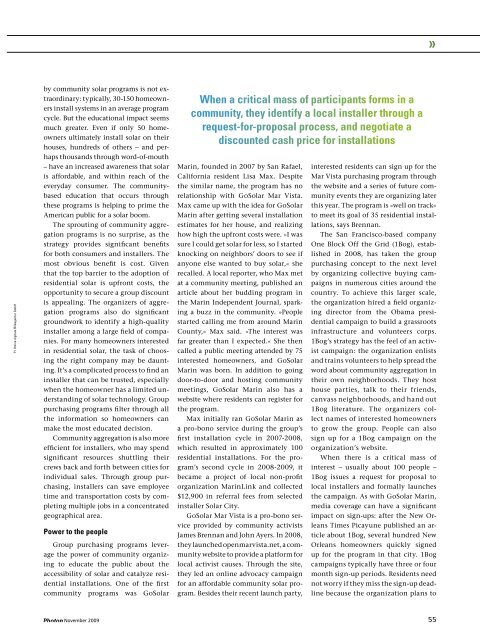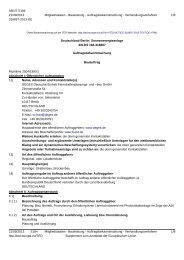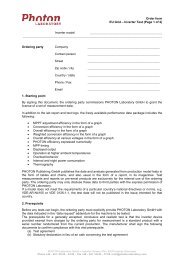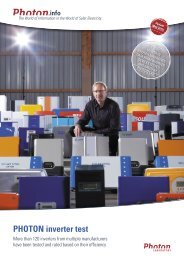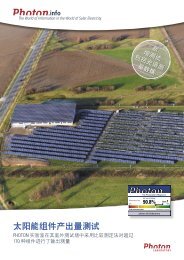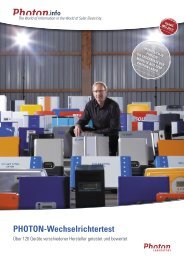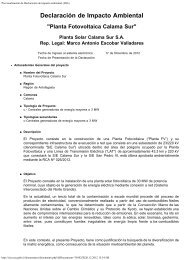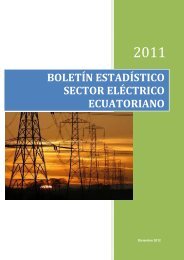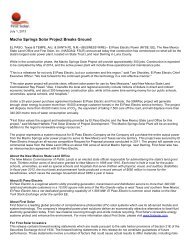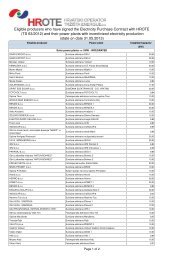INTRODUCTORY SPECIAL INTRODUCTORY ... - PHOTON Info
INTRODUCTORY SPECIAL INTRODUCTORY ... - PHOTON Info
INTRODUCTORY SPECIAL INTRODUCTORY ... - PHOTON Info
You also want an ePaper? Increase the reach of your titles
YUMPU automatically turns print PDFs into web optimized ePapers that Google loves.
F1 Online digitale Bildagentur GmbH<br />
by community solar programs is not ex-<br />
traordinary: typically, 30-150 homeown-<br />
ers install systems in an average program<br />
cycle. But the educational impact seems<br />
much greater. Even if only 50 home-<br />
owners ultimately install solar on their<br />
houses, hundreds of others – and per-<br />
haps thousands through word-of-mouth<br />
– have an increased awareness that solar<br />
is affordable, and within reach of the<br />
everyday consumer. The community-<br />
based education that occurs through<br />
these programs is helping to prime the<br />
American public for a solar boom.<br />
The sprouting of community aggre-<br />
gation programs is no surprise, as the<br />
strategy provides significant benefits<br />
for both consumers and installers. The<br />
most obvious benefit is cost. Given<br />
that the top barrier to the adoption of<br />
residential solar is upfront costs, the<br />
opportunity to secure a group discount<br />
is appealing. The organizers of aggre-<br />
gation programs also do significant<br />
groundwork to identify a high-quality<br />
installer among a large field of compa-<br />
nies. For many homeowners interested<br />
in residential solar, the task of choos-<br />
ing the right company may be daunt-<br />
ing. It’s a complicated process to find an<br />
installer that can be trusted, especially<br />
when the homeowner has a limited un-<br />
derstanding of solar technology. Group<br />
purchasing programs filter through all<br />
the information so homeowners can<br />
make the most educated decision.<br />
Community aggregation is also more<br />
efficient for installers, who may spend<br />
significant resources shuttling their<br />
crews back and forth between cities for<br />
individual sales. Through group pur-<br />
chasing, installers can save employee<br />
time and transportation costs by com-<br />
pleting multiple jobs in a concentrated<br />
geographical area.<br />
Power to the people<br />
Group purchasing programs lever-<br />
age the power of community organiz-<br />
ing to educate the public about the<br />
accessibility of solar and catalyze resi-<br />
dential installations. One of the first<br />
community programs was GoSolar<br />
When a critical mass of participants forms in a<br />
community, they identify a local installer through a<br />
request-for-proposal process, and negotiate a<br />
discounted cash price for installations<br />
Marin, founded in 2007 by San Rafael,<br />
California resident Lisa Max. Despite<br />
the similar name, the program has no<br />
relationship with GoSolar Mar Vista.<br />
Max came up with the idea for GoSolar<br />
Marin after getting several installation<br />
estimates for her house, and realizing<br />
how high the upfront costs were. »I was<br />
sure I could get solar for less, so I started<br />
knocking on neighbors’ doors to see if<br />
anyone else wanted to buy solar,« she<br />
recalled. A local reporter, who Max met<br />
at a community meeting, published an<br />
article about her budding program in<br />
the Marin Independent Journal, spark-<br />
ing a buzz in the community. »People<br />
started calling me from around Marin<br />
County,« Max said. »The interest was<br />
far greater than I expected.« She then<br />
called a public meeting attended by 75<br />
interested homeowners, and GoSolar<br />
Marin was born. In addition to going<br />
door-to-door and hosting community<br />
meetings, GoSolar Marin also has a<br />
website where residents can register for<br />
the program.<br />
Max initially ran GoSolar Marin as<br />
a pro-bono service during the group’s<br />
first installation cycle in 2007-2008,<br />
which resulted in approximately 100<br />
residential installations. For the pro-<br />
gram’s second cycle in 2008-2009, it<br />
became a project of local non-profit<br />
organization MarinLink and collected<br />
$12,900 in referral fees from selected<br />
installer Solar City.<br />
GoSolar Mar Vista is a pro-bono ser-<br />
vice provided by community activists<br />
James Brennan and John Ayers. In 2008,<br />
they launched openmarvista.net, a com-<br />
munity website to provide a platform for<br />
local activist causes. Through the site,<br />
they led an online advocacy campaign<br />
for an affordable community solar pro-<br />
gram. Besides their recent launch party,<br />
November 2009 55<br />
»<br />
interested residents can sign up for the<br />
Mar Vista purchasing program through<br />
the website and a series of future com-<br />
munity events they are organizing later<br />
this year. The program is »well on track«<br />
to meet its goal of 35 residential instal-<br />
lations, says Brennan.<br />
The San Francisco-based company<br />
One Block Off the Grid (1Bog), estab-<br />
lished in 2008, has taken the group<br />
purchasing concept to the next level<br />
by organizing collective buying cam-<br />
paigns in numerous cities around the<br />
country. To achieve this larger scale,<br />
the organization hired a field organiz-<br />
ing director from the Obama presi-<br />
dential campaign to build a grassroots<br />
infrastructure and volunteers corps.<br />
1Bog’s strategy has the feel of an activ-<br />
ist campaign: the organization enlists<br />
and trains volunteers to help spread the<br />
word about community aggregation in<br />
their own neighborhoods. They host<br />
house parties, talk to their friends,<br />
canvass neighborhoods, and hand out<br />
1Bog literature. The organizers col-<br />
lect names of interested homeowners<br />
to grow the group. People can also<br />
sign up for a 1Bog campaign on the<br />
organization’s website.<br />
When there is a critical mass of<br />
interest – usually about 100 people –<br />
1Bog issues a request for proposal to<br />
local installers and formally launches<br />
the campaign. As with GoSolar Marin,<br />
media coverage can have a significant<br />
impact on sign-ups: after the New Or-<br />
leans Times Picayune published an ar-<br />
ticle about 1Bog, several hundred New<br />
Orleans homeowners quickly signed<br />
up for the program in that city. 1Bog<br />
campaigns typically have three or four<br />
month sign-up periods. Residents need<br />
not worry if they miss the sign-up dead-<br />
line because the organization plans to


